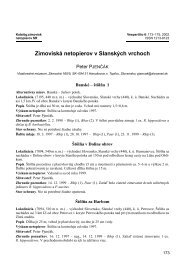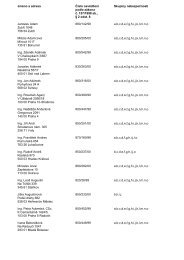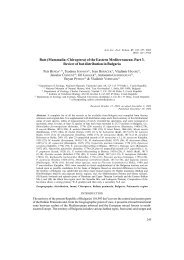Gyraulus parvus (Mollusca: Gastropoda) in the Czech Republic
Gyraulus parvus (Mollusca: Gastropoda) in the Czech Republic
Gyraulus parvus (Mollusca: Gastropoda) in the Czech Republic
- No tags were found...
Create successful ePaper yourself
Turn your PDF publications into a flip-book with our unique Google optimized e-Paper software.
efore distal angle of discoidal triangle, and aligned with concave Mspl; Mspl well def<strong>in</strong>ed, nearlystrait <strong>in</strong> its basal half but slightly curved <strong>in</strong> distal part; 2 rows of cells between Mspl and MP and5 rows between Mspl and MA; 2 rows of cells and a zigzagged supplementary ve<strong>in</strong> <strong>in</strong> distal part ofarea between MA and RP3/4; bulge <strong>in</strong> distal part of MA (“aeshnid bulla”) weak; 2 preserved Bqcross-ve<strong>in</strong>s; oblique ve<strong>in</strong> ’O’ not preserved; Rspl well def<strong>in</strong>ed and slightly anteriorly curved <strong>in</strong> itsdistal part; area between Rspl and IR2 very wide, with about 5 rows of cells <strong>in</strong> its widest part; spacebetween IR2 and Rspl basally divided by oblique <strong>in</strong>tercalary ve<strong>in</strong>lets; IR2 smoothly curved distallybut not forked; a long and ra<strong>the</strong>r straight <strong>in</strong>tercalary ve<strong>in</strong>, close and well parallel to RP2, proximallynot branch<strong>in</strong>g on IR2 but vanish<strong>in</strong>g <strong>in</strong> area between RP2 and IR2; RP2 strongly curvedposteriorly opposite proximal side of pterostigma; 5 rows of cells between RP2 and IR2 <strong>in</strong> widestpart; IR1 present but zigzagged, 6.8 mm long, beg<strong>in</strong>n<strong>in</strong>g just below proximal side of pterostigma;one row of cells between MP and CuAa; CuAa with more than 8 posterior branches directedtowards posterior w<strong>in</strong>g marg<strong>in</strong>; cubito-anal area very broad.TYPE MATERIAL. Holotype: specimen P1193 (National Museum coll., Praha, <strong>Czech</strong> <strong>Republic</strong>), medio-distal part offore w<strong>in</strong>g (impr<strong>in</strong>t) with venation well preserved, only posterior part of w<strong>in</strong>g preserved <strong>in</strong> counter impr<strong>in</strong>t.TYPE LOCALITY. Kundratice near Litomice, <strong>Czech</strong> <strong>Republic</strong>.TYPE STRATA. Lower Oligocene (Ruppelian/Chattian), Ústí Formation (Stedohoí Complex).ETYMOLOGY. Named after <strong>the</strong> dark <strong>in</strong>fuscate w<strong>in</strong>g of <strong>the</strong> type specimen.DISCUSSION. Kvacekia gen. n. fits <strong>in</strong>to <strong>the</strong> Aeshnidae because of <strong>the</strong> presence of several potentialautapomorphies (after Bechly 1996): “Rspl and Mspl dist<strong>in</strong>ctly curved, with more than 3 rows ofFig. 1. Geographical position of northwestern Bohemia with<strong>in</strong> Europe (A), detailed map of <strong>the</strong> Most Bas<strong>in</strong> and<strong>the</strong> eské stedohoí volcanic areas (B), 1 – Bíl<strong>in</strong>a m<strong>in</strong>e, 2 – Kundratice near Litomice.143








